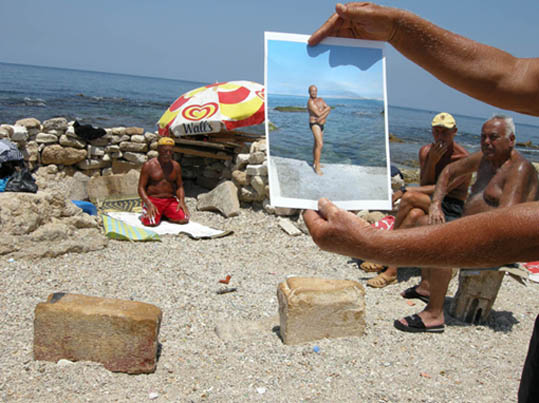About Menocchio we know many things.

- View of the exhibition "About Menocchio, we know many things." Bétonsalon - Center for Art and Research, Paris, 2012. Image: Aurélien Mole
Etel Adnan, Mohammed Aïssaoui, Mounira Al Solh, Anahi Alviso-Marino, Dineo Seshee Bopape, Michèle Firk, Michel François, Olivier Hadouchi, Pierre Joseph & Jacques Rivet, Carole Roussopoulos, Larisa Shepitko, The Berwick Street Collective, Eric Watier, Peter Weiss
About Menocchio we know many things. About this Marcato, or Marco – and so many others like him who lived and died without leaving a trace – we know nothing.
Carlo Ginzburg, The Cheese and the Worms: The Cosmos of a 16th-Century Miller, 1980 (1976)

- Mounira Al Solh, Moment 4, photograph extracted from the project The Sea Is A Stereo, 2007- 2010. Courtesy of Sfeir-Semler Gallery, Hambourg / Beyrouth
In The Cheese and the Worms: The Cosmos of a Sixteenth Century Miller (1976), the historian Carlo Ginzburg recounts the story of a miller’s life in the XVIth century who was arrested and executed by the Church because of his radical ideas about Christianity. Through an investigative study of archival material, Ginzburg examines and interprets the signs and traces left by this metaphysician miller’s thought, revealing the popular culture of the time. This narrative is a symbolic example of Ginzburg’s notion of microstoria: by reducing the scope of observation, one can expand the field of History towards unique stories.
The exhibition "About Menocchio we know many things." uses the micro-historical method of Carlo Ginzburg to shed light on individual paths, specifically drawing attention to those little considered by traditional historiography. Gathering works by artists, writers, sociologists and activists from 1960s until today the exhibition tries to make visible diverse forms of resistance to the formatting of a globalised world. In giving particular attention to details, clues or fragments, "About Menocchio we know many things." explores the potential of agency and empowerment of these singular positions through art and narrative.
With special support of LUX distribution

Share